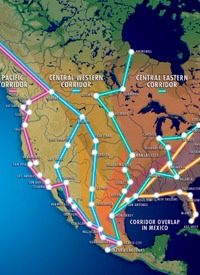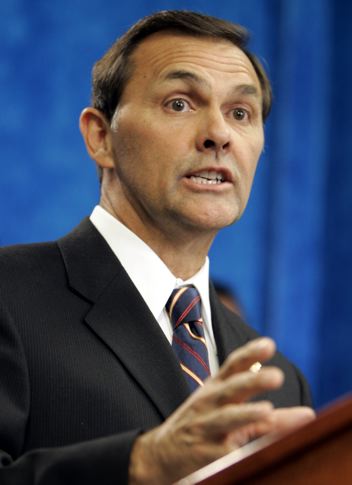
While Spain’s present king, Juan-Carlos, isn’t attempting to conquer modern America, a system startlingly similar to the ancient caminos reales is being fashioned, constructed by a Spanish company, Cintra. In the form of the NASCO SuperCorridor, a transport network is being implemented right under our noses for the purposes of accelerating the movement of goods and people across the Rio Grande and facilitating the creation of a North American Union (NAU), wherein our borders with Mexico and Canada would become as meaningless as our state lines are now. This is well documented in a variety of sources. One of the most comprehensive sources is Building a North American Community, the Council on Foreign Relations Task Force Report about how to create a North American Union, which explains the necessity of this transportation infrastructure for integrating Canada, Mexico, and the United States into a regional government.
High-priority highway corridors — collectively dubbed the “NAFTA Superhighway” by critics — are planned coast to coast and, in Texas, are already under construction. That’s unsettling. But the mischief doesn’t stop there. And this time, the road enjoys better than a king’s protection because it’s being implemented with the active participation and direction of a U.S. president — George W. Bush. But, precisely because President Bush is acting like a king in this matter, trying to impose his will without approval of the people or oversight by Congress, citizen-activists are assembling above and below Texas’ northern border, the legendary Red River, to oppose his plans.
The Trans Texas Corridor-35 (TTC-35), a segment of the NAFTA Superhighway, runs parallel to (and sometimes coexistent with) the current Interstate 35. Though massive in scale, it’s only a part of the bigger road system planned from Mexico’s west coast all the way through Canada. Its geographical and political positions make it ground zero of a watershed conflict for American independence, which would no longer exist should America become a province of the NAU. The TTC-35, much of which would be a 12-lane-wide monster of concrete, cabling, pipelines, toll roads, electronic surveillance capabilities, rails, depots, and an appetite for property rivaling the British Empire, has taken on a life of its own and is literally steamrolling over Texans, heading north. Designed for, among other things, the transport of cheap goods from China through Mexico into America’s heartland, it will facilitate border crossings at the Rio Grande virtually free of security checks.
Grass-roots Reaction
New readers should know that NASCO (North America’s SuperCorridor Coalition) claims that the SuperCorridor is the largest engineering project ever undertaken in U.S. history — ever. You’d think that would attract attention. Yet the measure authorizing the Texas segment was passed by the Texas Legislature with virtually no knowledge by the voters, though it represented the largest spending bill in Texas history (H.B. 3588).
Now grass-roots organizations, property owners, environmentalists, constitutionalists, and others recognize the Trans Texas Corridor and the whole concept of a North American superhighway as a big, fat uh-oh and have relentlessly pressured their lawmakers to stop their implementation. The current crop of Texas legislators is between a rock and a hard place — either accede to Texas Governor Rick Perry’s demands for the Trans Texas Corridor or listen to their constituents.
Many Texas legislators are opting to heed the call of their constituents and are working to pull the plug on the deal. This spring, Representative Lois Kolkhorst, the scrappy state legislator from Brenham, Texas, authored an amendment to this year’s transportation bill, H.B. 1892, requiring the state to place a two-year moratorium on entering into contracts with private entities, and to submit the Cintra deal (finally!) to analysis. She also introduced legislation that would force the Texas attorney general to examine agreements, such as documents pertaining to the North American Union or NAFTA, that threaten Texas sovereignty.
Because of the success of the constituency groups, the Bush administration is trying to coerce the Texas legislators, and Texans in general, into going against their best judgment and allowing the highway to be built. As the moratorium bill was pending, Texas Senator Kay Bailey Hutchison received a letter from the Federal Highway Administration’s J. Richard Capka expressing concerns that “Senate amendments … may make it impossible for Texas to administer the [Federal-aid Highway] Program in a manner consistent with Federal law.” In other words, Texas was threatened with loss of federal highway funds if the moratorium bill is passed. The bill passed anyway — in the Texas House by a near-unanimous 139-1, and in the Senate by 27-4 — and then was sent to Governor Perry’s desk.
Perry vetoed the bill on May 18 and has been lobbying legislators for a “compromise” bill (SB 792), essentially allowing the SuperCorridor juggernaut to continue rolling. Rep. Kolkhorst stepped up to the plate again, adding a critical amendment to keep the moratorium in place, and effectively defanging the bill. Obviously, there are enough votes to override Perry’s veto — unless the governor and the NASCO forces can buy or coerce a large number of votes in both houses. So, the fight is still on in the Lone Star State, as we write.
While Texans have been struggling simultaneously to stop the end-run made around them and to undercut the corridor, a low-pressure storm has been brewing to the north. Since any proposed SuperCorridor in Texas must cross the Red River, Oklahomans sniffed the wind for danger, and they found it. They realized that they were the second line of defense if the front line collapsed. What to do?
Last fall, members of the influential Oklahoma Conservative Political Action Committee (OCPAC) got a wake-up call from the special (October 2, 2006) “North American Union” issue of THE NEW AMERICAN. The issue revealed the agenda of the NAU proponents and the SuperCorridor’s role in that agenda. Tulsa activists and a handful of OCPAC members formed OK-SAFE, Inc. (Oklahomans for Sovereignty and Free Enterprise), an educational and lobbying group, for the main purpose of stopping the corridor. Calling upon influence forged through OCPAC, they promptly distributed copies of the NAU special issue of TNA as part of an information packet to legislators and became well known at the capitol. OK-SAFE’s crack researchers began to be consulted by Oklahoma lawmakers, who started to take the matter seriously.
Patriots’ Persistence Pays Off
 |
| State Senator Randy Brogdon. |
As knowledge spread about the corridor’s sheer scope and about its origins as a major NAU component, resistance to the corridor grew. But that didn’t stop legislators from introducing measures to prompt its construction. Fortunately, a sharp-eyed legislator who had been informed by the OK-SAFE campaign spotted a bill (H.B. 1917) that would be used by pro-NAU forces to facilitate the corridor’s river crossing. He alerted the OK-SAFE members, who sounded the alarm to other concerned citizens. On the day the bill was to be heard by Oklahoma lawmakers, OK-SAFE members appeared at the capitol and distributed a copy of THE NEW AMERICAN NAU issue to each legislator. Along with the magazine, they distributed a packet of independent research and supporting documents that included a bullet list detailing the main dangers and concerns in H.B. 1917’s language. The OK-SAFE educational effort stirred such strong opposition that the bill was never brought up for a hearing.
However, that didn’t end the threat. After H.B. 1917 was stopped in the House, the same language appeared in another bill as a committee substitute on the Senate side. This new bill, H.B. 1819, had its original wording bumped in favor of pro-SuperCorridor language. The battle was back on to educate the legislators and stop H.B. 1819. OK-SAFE again jumped into the fray, and the bill was defeated. Oklahoma state Senator Randy Brogdon, who argued against H.B. 1819 on the Senate floor, told THE NEW AMERICAN after the vote that “this legislation was potentially another step of a stealth movement to expand the NAFTA Superhighway through Oklahoma.” He added that “protecting the sovereignty of this nation is far more important than building an international highway system, which could eliminate our trade and security borders.”
Brogdon also sponsored Senate Concurrent Resolution 10 “urging the United States to withdraw from the Security and Prosperity Partnership of North America and any other activity which seeks to create a North American Union.” The resolution explicitly cites the NAFTA Superhighway as part of that subversive scheme. The Oklahoma House passed it 97-0 on May 15 and the Senate passed it by voice vote two days later, making Oklahoma the third state (Idaho and Montana being the first two) to pass a resolution urging Congress to oppose a North American Union.
Oklahoma state Rep. Charles Key, the principal sponsor of Sen. Con. Res. 10 in the House, told us: “There is a real level of knowledge within the legislature about the North American Union and the Security and Prosperity Partnership because of the educational work the John Birch Society has done. All 97 members of the House present and voting [on Sen. Con. Res. 10] agreed to cosponsor the resolution — reflecting the strong sentiment in the Oklahoma legislature against surrendering the independence of our country to a North American Union.”
Oklahoma’s opposition has been so potent, in fact, that it has drawn the attention of NASCO, whose Executive Director Tiffany Melvin traveled to Oklahoma on May 10 to try to persuade lawmakers that NASCO is innocuous and does not promote the NAU, SPP, or any superhighway connected to it!
During Melvin’s address to the legislature, highly dubious events took place: in the “publicly broadcast” Senate Transportation conference committee meeting, audio access was mysteriously turned off, limiting public knowledge of the proceedings, and citizen participants were not allowed their promised time to rebut the spurious pro-corridor arguments. Melvin, however, was given abundant time to reiterate repeatedly that she was there “to eliminate public confusion about NASCO and the SuperCorridor.”
She had her say, Oklahomans didn’t have theirs; but for now, the bill is dead — unless the enabling language allowing the corridor surfaces in yet another bill before the session ends on May 25. The modern-day battle at the OK Corral is both exciting and desperate, for if Texas fails to stop the corridor, it will be increasingly difficult for the next states in line. To head off the problem, Oklahomans are stepping up to defeat what could be the next Oklahoma land rush — only this time the state will be taking the land back.
Photo: AP Images



